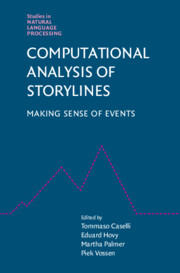Refine search
Actions for selected content:
3312 results in Artificial Intelligence and Natural Language Processing
Part Two - Connecting the Dots: Resources, Tools, and Representations
-
- Book:
- Computational Analysis of Storylines
- Published online:
- 06 November 2021
- Print publication:
- 25 November 2021, pp 143-144
-
- Chapter
- Export citation
6 - A Narratology-Based Framework for Storyline Extraction
- from Part One - Foundational Components of Storylines
-
- Book:
- Computational Analysis of Storylines
- Published online:
- 06 November 2021
- Print publication:
- 25 November 2021, pp 125-142
-
- Chapter
- Export citation
Frontmatter
-
- Book:
- Computational Analysis of Storylines
- Published online:
- 06 November 2021
- Print publication:
- 25 November 2021, pp i-vi
-
- Chapter
- Export citation
7 - The Richer Event Description Corpus for Event–Event Relations
- from Part Two - Connecting the Dots: Resources, Tools, and Representations
-
- Book:
- Computational Analysis of Storylines
- Published online:
- 06 November 2021
- Print publication:
- 25 November 2021, pp 145-162
-
- Chapter
- Export citation
12 - Semantic Storytelling: From Experiments and Prototypes to a Technical Solution
- from Part Two - Connecting the Dots: Resources, Tools, and Representations
-
- Book:
- Computational Analysis of Storylines
- Published online:
- 06 November 2021
- Print publication:
- 25 November 2021, pp 240-259
-
- Chapter
- Export citation
5 - Event Causality
- from Part One - Foundational Components of Storylines
-
- Book:
- Computational Analysis of Storylines
- Published online:
- 06 November 2021
- Print publication:
- 25 November 2021, pp 106-124
-
- Chapter
- Export citation
2 - The Rich Event Ontology: Ontological Hub for Event Representations
- from Part One - Foundational Components of Storylines
-
- Book:
- Computational Analysis of Storylines
- Published online:
- 06 November 2021
- Print publication:
- 25 November 2021, pp 47-66
-
- Chapter
- Export citation
Introduction and Overview
-
- Book:
- Computational Analysis of Storylines
- Published online:
- 06 November 2021
- Print publication:
- 25 November 2021, pp 1-20
-
- Chapter
- Export citation
Author Index
-
- Book:
- Computational Analysis of Storylines
- Published online:
- 06 November 2021
- Print publication:
- 25 November 2021, pp 260-260
-
- Chapter
- Export citation
10 - Narrative Homogeneity and Heterogeneity in Document Categories
- from Part Two - Connecting the Dots: Resources, Tools, and Representations
-
- Book:
- Computational Analysis of Storylines
- Published online:
- 06 November 2021
- Print publication:
- 25 November 2021, pp 203-220
-
- Chapter
- Export citation
Contents
-
- Book:
- Computational Analysis of Storylines
- Published online:
- 06 November 2021
- Print publication:
- 25 November 2021, pp vii-x
-
- Chapter
- Export citation
Reducing repetition in convolutional abstractive summarization
-
- Journal:
- Natural Language Engineering / Volume 29 / Issue 1 / January 2023
- Published online by Cambridge University Press:
- 24 November 2021, pp. 81-109
-
- Article
- Export citation

Computational Analysis of Storylines
- Making Sense of Events
-
- Published online:
- 06 November 2021
- Print publication:
- 25 November 2021
Copyright page
-
- Book:
- Artificial Economics
- Published online:
- 28 October 2021
- Print publication:
- 04 November 2021, pp iv-iv
-
- Chapter
- Export citation
3 - Artificial Games
- from Part I - Artificial Economics and Mainstream Economics
-
- Book:
- Artificial Economics
- Published online:
- 28 October 2021
- Print publication:
- 04 November 2021, pp 50-59
-
- Chapter
- Export citation
Annexes
- from Part II - Complementary Topics and Discussions
-
- Book:
- Artificial Economics
- Published online:
- 28 October 2021
- Print publication:
- 04 November 2021, pp 138-164
-
- Chapter
- Export citation
Contents
-
- Book:
- Artificial Economics
- Published online:
- 28 October 2021
- Print publication:
- 04 November 2021, pp vii-viii
-
- Chapter
- Export citation
8 - Artificial Economics and the Agent/Structure Problem
- from Part II - Complementary Topics and Discussions
-
- Book:
- Artificial Economics
- Published online:
- 28 October 2021
- Print publication:
- 04 November 2021, pp 128-137
-
- Chapter
- Export citation
Part I - Artificial Economics and Mainstream Economics
-
- Book:
- Artificial Economics
- Published online:
- 28 October 2021
- Print publication:
- 04 November 2021, pp 5-70
-
- Chapter
- Export citation
Preface
-
- Book:
- Artificial Economics
- Published online:
- 28 October 2021
- Print publication:
- 04 November 2021, pp xiii-xvi
-
- Chapter
- Export citation
